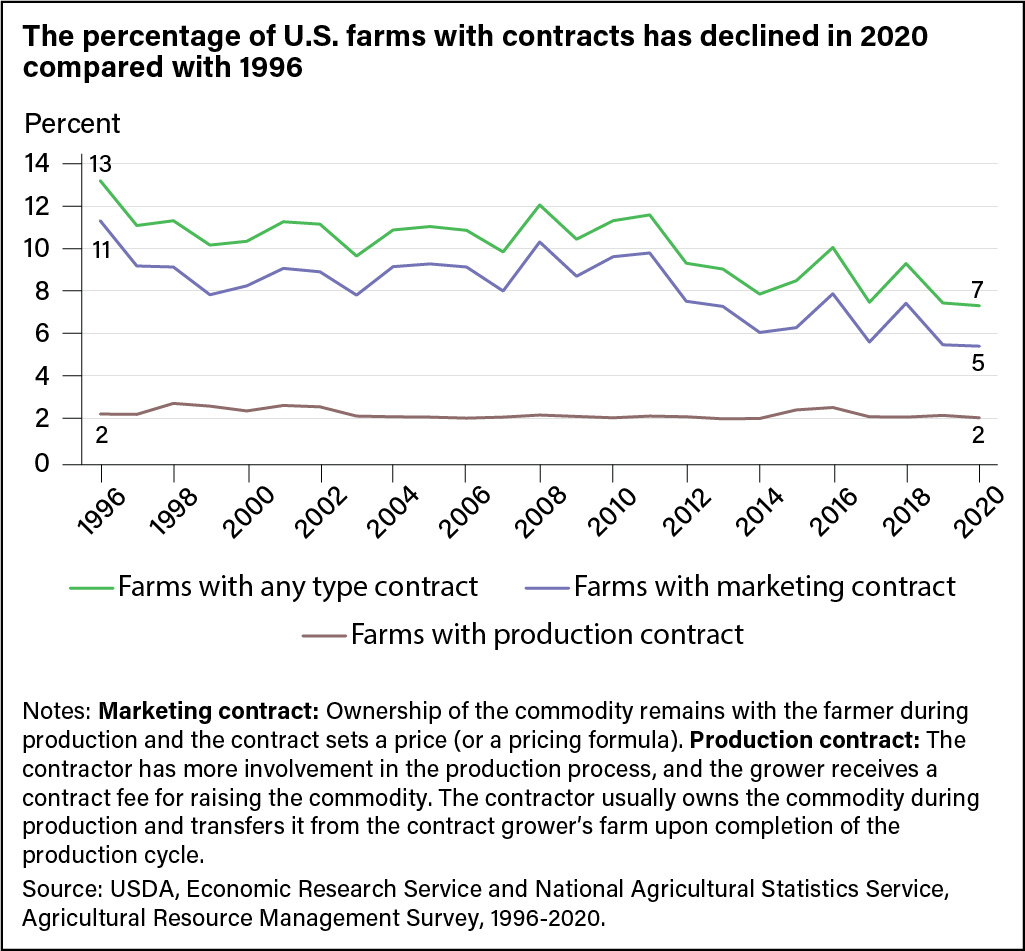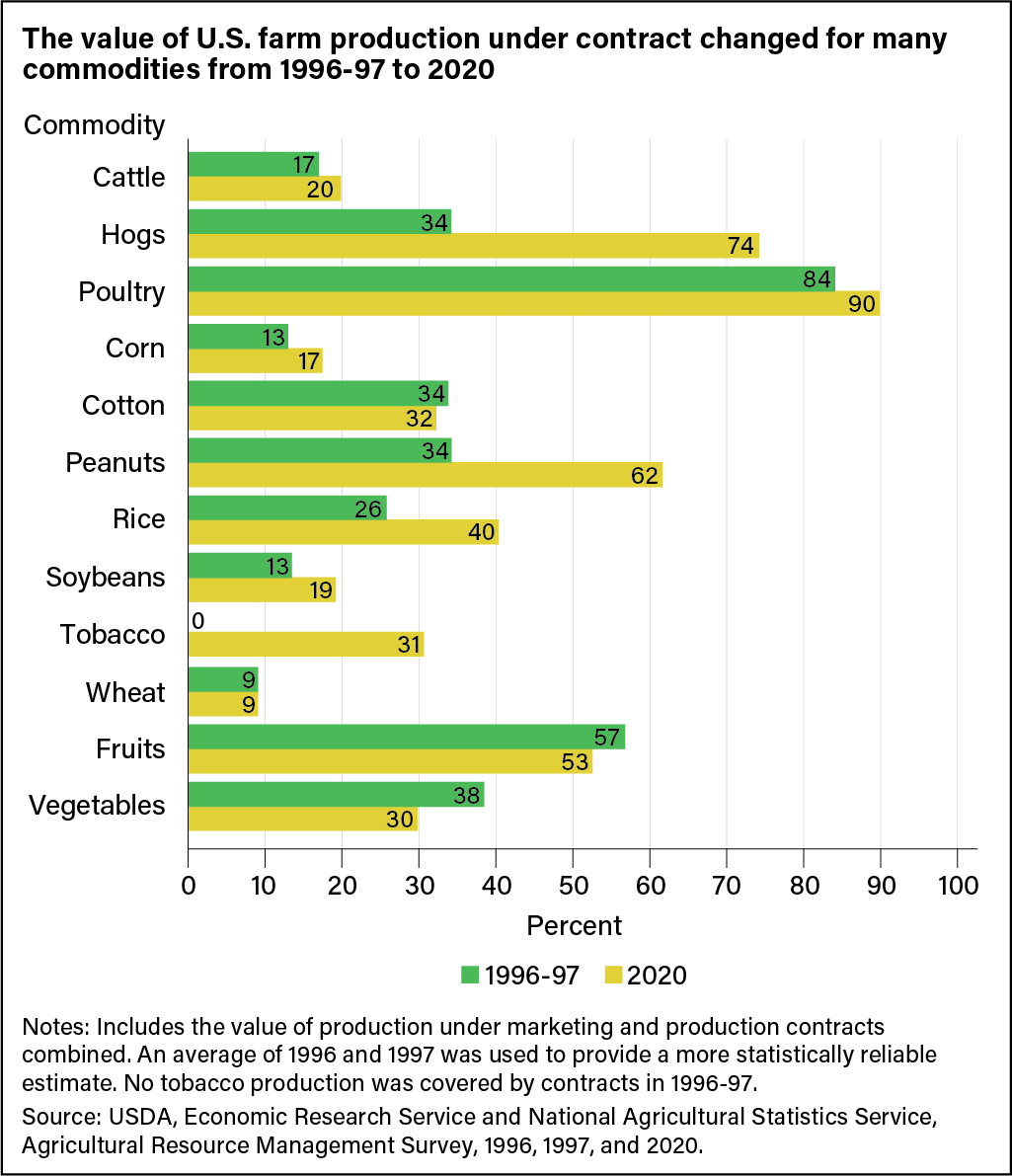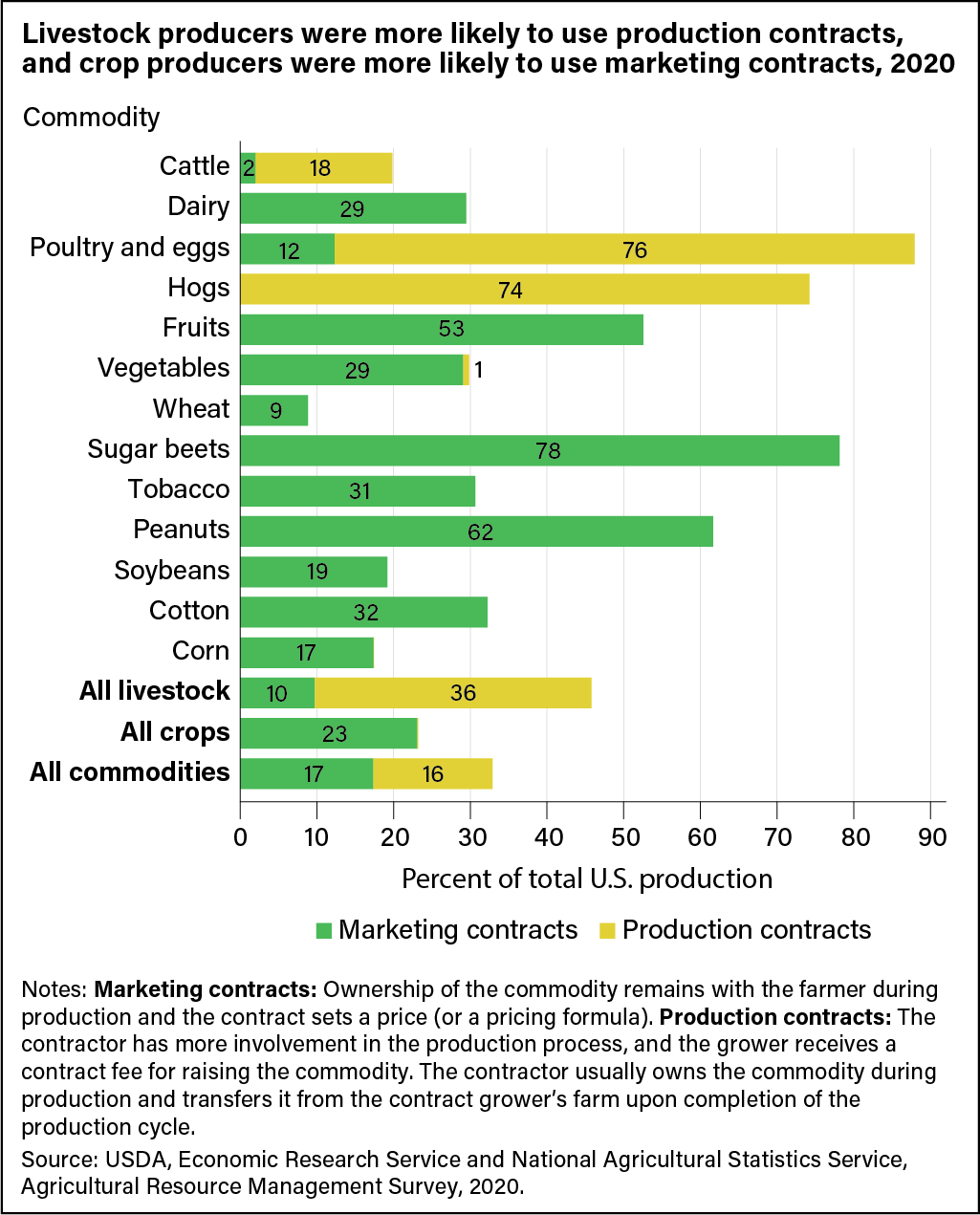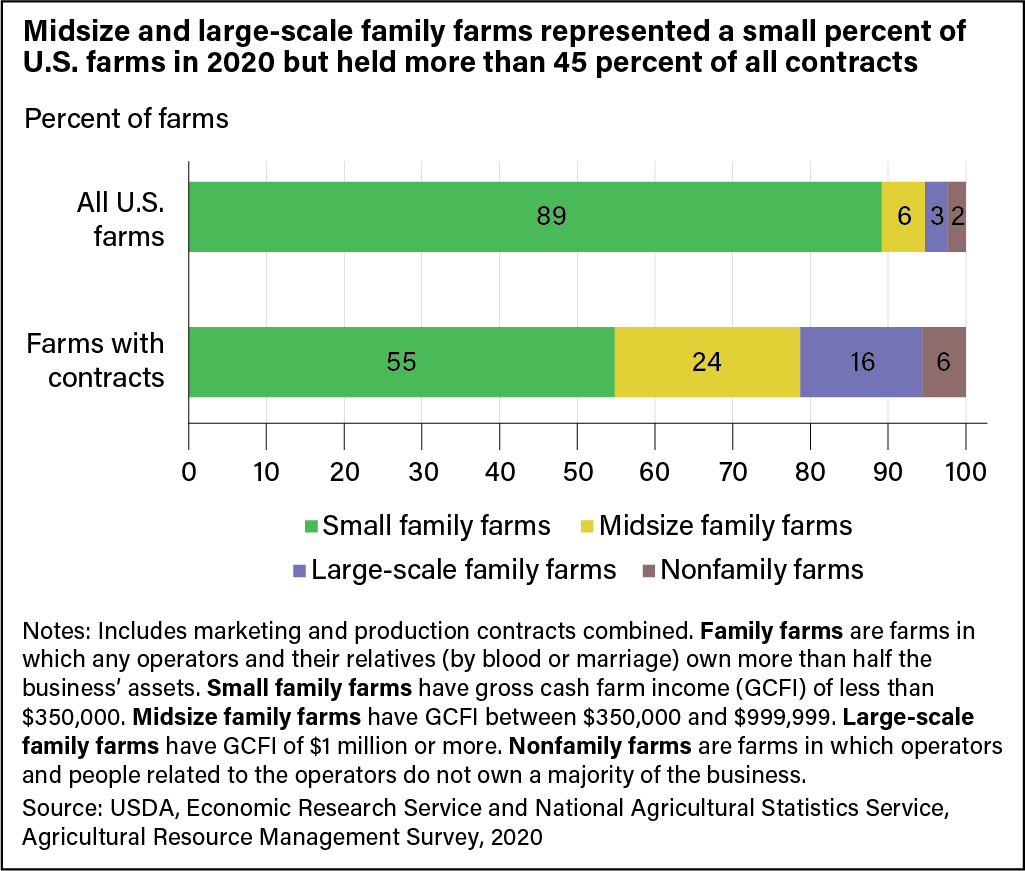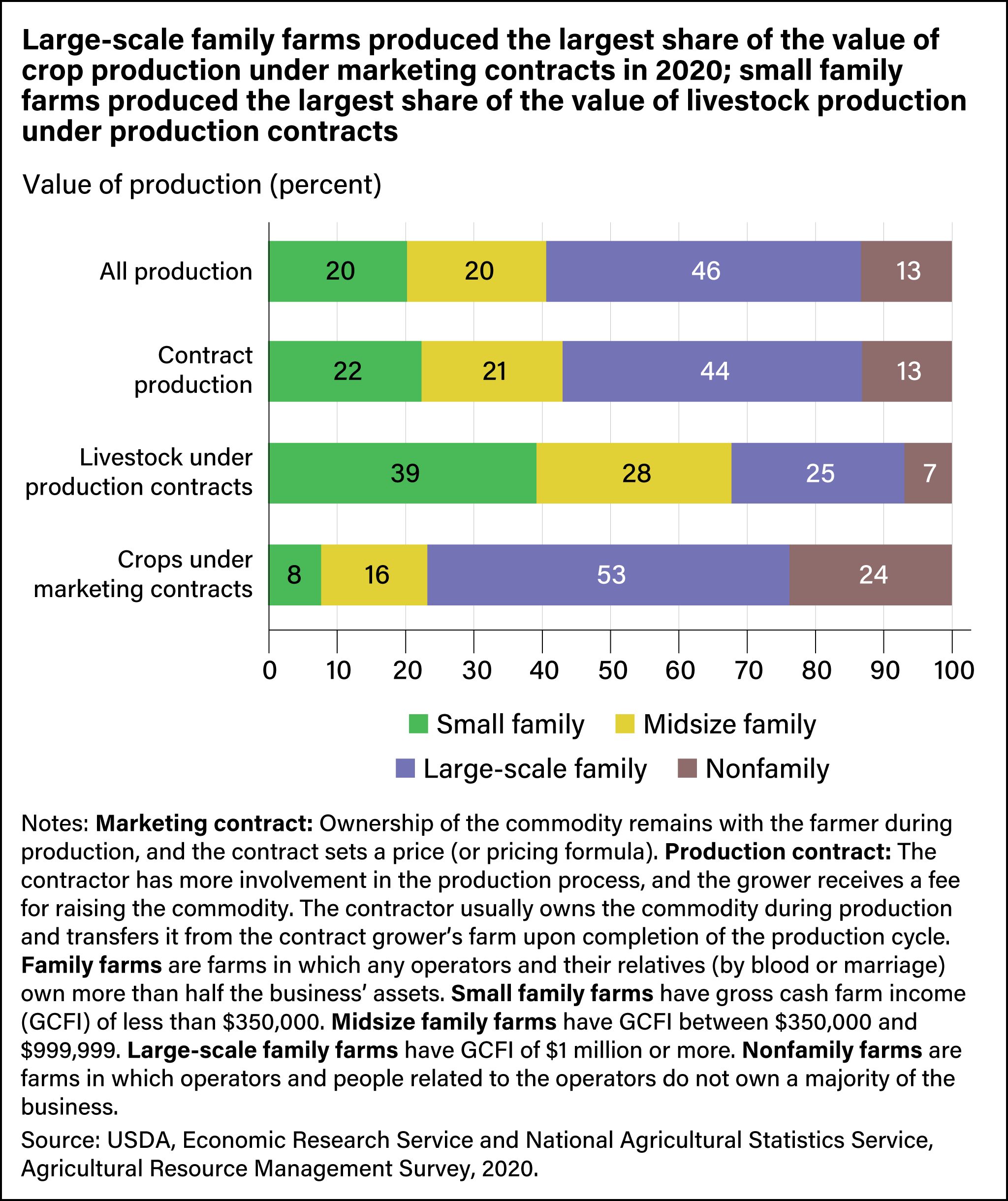
Farmers’ Use of Contracts Has Declined Over Last 25 Years
- by Christine Whitt
- 6/23/2022
A contract governing the production of agricultural commodities is a legal agreement between a farm operator (or producer) and another person or firm (a contractor or integrator) to produce a specific type, quantity, and quality of crops or livestock. The use of contracts, instead of traditional cash sales, is one tool producers use to manage income risks. Other strategies include diversifying production, hedging through futures markets, participating in Federal crop insurance, and investing in on-farm storage. Producers also use contracts to guarantee they are compensated appropriately for higher quality products, to create specific outlets for their products, and to provide assurance for debt financing.
Contractors are intermediaries who coordinate production. They could be processors or other buyers who contract to maintain timely flows of specific products, ensure a higher level of food safety, and gain greater control over the characteristics and consistency of the products they acquire.
USDA, Economic Research Service (ERS) classifies contracts as either marketing or production, both of which are established before crops are harvested or livestock production cycles are complete.
- Marketing contracts. Ownership of commodities stays with farmers during production. The contract sets a price or pricing formula, product quantities and qualities, and a delivery schedule. Contractor involvement with production is minimal. Typically, crop farmers use marketing contracts, working with intermediaries such as milling operators or ethanol plants.
- Production contracts. Contractors usually own the commodity during production. They provide inputs and services, production guidelines, and technical advice to the producer. For example, contractors typically provide feed, veterinary services, transportation, and young animals. Farmers receive a fee for producing the commodity. Typically, livestock producers use production contracts, establishing them with contractors who own the processing and distribution of the processed meat.
Use of Contracts Declined Over the Past 25 Years, While the Share in the Total Value of Production Under Contract Has Been Relatively Stable
ERS researchers track information about agricultural contracts that govern the transfer of production to non-farm entities using data from USDA’s Agricultural Resource Management Survey. Between 1996 and 2020, the percentage of farms using contracts—marketing and production combined—to manage the disposition of their farm commodity production has declined. In 2020, 7 percent of U.S. farms used contracts, compared with 13 percent in 1996. The decline was mostly in marketing contracts. In 2020, 5 percent of U.S. farms used marketing contracts, compared with 11 percent in 1996. The share of U.S. farms using production contracts remained stable at 2 percent.
Even though farmers are using contracts less often, the share of the value of commodities under marketing and production contracts has stayed level. This has occurred despite year-to-year fluctuations resulting from changes in price or in quantity produced. In 2020, the total value of production under a marketing or production contract represented nearly one-third of the value of all U.S. production, similar to that in 1996. However, the share of the value of production governed by the individual type of contract—production or marketing—varied during this period. The share of the value of commodities under a production contract increased from 12 percent in 1996 to 16 percent in 2020, and the share produced under a marketing contract dropped from 21 percent in 1996 to 17 percent in 2020. Most recently, from 2019 to 2020, the share in the total value of commodities produced under contract (both marketing and production) increased.
More of the Value of Livestock Production Is Produced Under Contract Than Crop Production
As has been true since ERS researchers first started tracking trends in the use of contracts more than 25 years ago, a larger percent of total U.S. output is produced under livestock contract than crop contract. In 2020, 20 percent of the total value of U.S. production was produced under a livestock contract, and 13 percent was produced under a crop contract.
Although the importance of contracting in both the crop and livestock sectors has been relatively stable over time, contracting varies significantly among individual commodities. Furthermore, the use of contracting across individual commodities has changed over the 25-year period for a variety of complex and interrelated reasons. These factors include changes in agricultural policies, world markets, industry consolidation, and technological changes.
Contracts cover relatively small shares of corn, soybean, and wheat production, and there has been little change in those shares for more than 20 years. Contract use grew between the 1996-97 period and 2020 for peanuts, tobacco, and hogs. Between those two periods, changes in Federal commodity programs led to important shifts in marketing channels for peanuts and tobacco. The expansion of contracting in hogs was part of a major industry reorganization toward larger facilities that are tightly integrated with one another. Contracting was already firmly established in poultry and eggs by the late 1990s and the percent of poultry production under contract increased only slightly from 1996-97 to 2020. The use of contracts in fruit and vegetable production declined between the 1996-97 period and 2020.
For all U.S. farms, the value of contract production was nearly evenly split between marketing and production contracts in 2020. However, the use of contract types varied across commodities. Except for some vegetables, most contracted crop production falls under marketing contracts. Hog and poultry farmers use production contracts extensively, while dairy producers use marketing contracts. In the case of hogs, some are raised under a production contract between a grower and a contractor and then sold by the contractor under a marketing contract with a processor.
Just as the Total Value of U.S. Production Is Concentrated on Larger Farms, so Is the Value of Production Under Contract
Small family farms—those with less than $350,000 in annual sales—accounted for 89 percent of all U.S. farms in 2020. However, small family farms accounted for only 55 percent of farms with contracts, representing only 22 percent of the value of all U.S. production under contract in 2020. Conversely, large-scale family farms, with at least $1 million in sales, amounted to 3 percent of U.S. farms but 16 percent of farms with contracts and 44 percent of the value of production under contract in 2020.
Small family farms accounted for about 20 percent of the value of all agricultural production in 2020 and a similar share of the value of contract production. Large-scale family farms accounted for 46 percent of the value of all production and 44 percent of contract production. The focus of contract production differed between small and large-scale family farms. Small farms often raised poultry or hogs under production contracts. Large-scale family farms produced 53 percent of crops sold under marketing contracts.
This article is drawn from:
- Farm Structure and Organization - Farm Structure and Contracting. (n.d.). U.S. Department of Agriculture, Economic Research Service.
You may also like:
- MacDonald, J.M. & Burns, C. (2019, July 1). Marketing and Production Contracts Are Widely Used in U.S. Agriculture. Amber Waves, U.S. Department of Agriculture, Economic Research Service.
- Burns, C. & MacDonald, J.M. (2018). America’s Diverse Family Farms: 2018 Edition. U.S. Department of Agriculture, Economic Research Service. EIB-203.
- MacDonald, J.M. & Korb, P. (2011). Agricultural Contracting Update: Contracts in 2008. U.S. Department of Agriculture, Economic Research Service. EIB-72.


